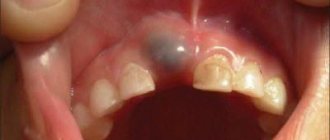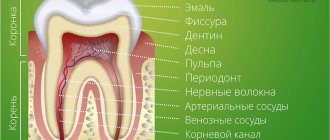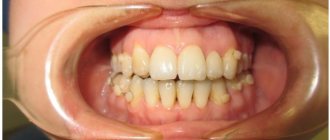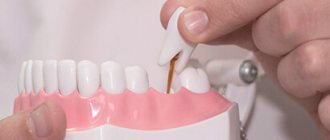What are baby teeth?
A child may believe that baby teeth are needed only so that the Tooth Fairy has something to build her snow-white castle from. But adults should know the truth. When a child is still very small, his head, and therefore his jaw, are small. If the baby, instead of milk teeth, began to cut molars immediately, they would not fit into the mouth either in size or in number. Therefore, nature gave us a temporary solution for the first ten years.
There are 20 primary teeth in total (10 each on the upper and lower jaws). These are incisors - central and lateral, canines, and molars. Usually, a child already has all of them at the age of 3-3.5 years.
Milk teeth differ from primary teeth not only in size, but also in structure. The enamel of primary teeth is approximately 2 times thinner and not as rich in minerals. Therefore, the child needs to carefully monitor oral hygiene - caries on baby teeth develops very quickly. Milk teeth have thin not only enamel, but also the layer underneath it - dentin - so caries quickly develops into pulpitis. Baby teeth have both nerves and roots, but they are shorter than molars. The latter gradually “dissolve” during the period of change of bite. This is why the teeth begin to loosen.
If baby teeth are not taken care of and treated, the child’s gums may become inflamed, and the embryos of the molars may suffer or die. Don't leave caries unattended!
What deviations from the norm may there be?
Each child develops individually. Sometimes the timing of the replacement of certain teeth may differ from the generally accepted norm. Minor deviations are allowed up to 12 months. But sometimes the change in the primary bite begins too early or, on the contrary, the temporary teeth do not want to fall out.
Causes:
- long-term breastfeeding;
- severe infectious diseases in infancy;
- pathologies of intrauterine development.
Reference!
Dentists believe that a safer deviation is a late change in the primary occlusion than vice versa.
Let us consider in detail the common violations and their causes.
Early tooth loss
We can talk about such a pathology if a child’s baby teeth begin to fall out before the age of 5. Possible reasons:
- advanced multiple caries;
- injury;
- gum disease;
- manual loosening of the tooth.
In all these cases, consultation with a pediatric dentist is required.
Important!
Parents should record the time of tooth loss. If after 4 months the permanent tooth does not begin to emerge, then the help of a doctor is required.
In case of early unnatural tooth loss, it is advisable to conduct an X-ray diagnosis. This will help to identify possible damage to the permanent root rudiment in time and begin treatment. Otherwise, the child will need prosthetics in the future.
Late change from primary to permanent occlusion
The deadline for starting the process of changing baby teeth is 8 years. But this is considered a late shift. The disorder may be caused by:
- heredity;
- metabolic disorders;
- infectious diseases suffered in early childhood;
- mental disorders.
If after 8 years a child has not lost a single baby tooth, this is a reason to consult a doctor.
How and when do teeth change?
Loss of primary teeth begins at approximately 6-7 years of age and usually lasts until 10-12 years of age. Note that girls say goodbye to temporary teeth earlier than boys and the replacement process itself is more dynamic for them.
Parents will be able to guess that their child’s baby teeth are about to change due to a number of factors: due to jaw growth, the distance between the incisors will increase, the rudiments of molars become visible under the baby teeth, and the primary teeth become loose.
On average, the age at which a child changes teeth corresponds to the years given in the tables below:
Order of loss of baby teeth
| Age | What teeth fall out |
| 6-7 years | Central incisors fall out |
| 7-8 years | Lateral incisors fall out |
| 9-11 years | The child loses his first molars |
| 10-12 | Canines and second molars fall out |
⠀
Please note that the new tooth may not be in a hurry to take the place of the fallen one. If a couple of weeks or even more than a month have passed and there is still no molar, this is not a reason to panic. Also keep in mind that there are more molars, so some take their place without changing their predecessors. For example, molars or (the first permanent molars), erupt from scratch at the age of 5-7 years - they should not be confused with milk teeth.
Growth of molars
Image source
Molars are called a little differently than baby teeth. Try not to get confused:
| Molar | Age of appearance | Which milk tooth replaces |
| Central incisors | 6-8 years | Central incisors |
| Lateral incisors | 7-9 years | Lateral incisors |
| Fangs | 10-13 years | Fangs |
| First premolars | 9-12 years | First molar |
| Second premolars | 10-13 years | Second molar |
| First molars | 5-7 years | Do not replace baby teeth |
| Second molars | 11-14 years old | Do not replace baby teeth |
| Third molars | 17-25 years old | Do not replace baby teeth |
⠀
If you do not take into account the third molars (which are also called wisdom teeth), girls receive a fully formed jaw by 11-13 years, and boys by 13-14 years.
It is important to understand that the baby tooth may not be replaced. For example, if the germ of a molar tooth has died, then nothing pushes the temporary tooth to leave the mouth. People live with partial milk teeth even into their 30s. Therefore, if a baby tooth does not fall out, you should not try to loosen it or try to pull it out at home. Below we will look at other problems when changing teeth.
Reasons for late eruption
Normally, after a baby tooth falls out, it takes 1-2 months for the permanent tooth to erupt. This is the longest period. In most cases, the rudiments of a permanent tooth can already be seen at the site of the lost tooth.
But, if a child’s toothless smile persists for 3 months or more, then this is a cause for concern for parents.
Let's consider why such dental pathology occurs:
- Retention
– a common condition that mainly affects the incisors and canines. They cannot erupt due to dense gums or because they rest against neighboring teeth. There are complete and partial retention. With the full form, a healthy root is visible in the picture, but it is completely under the gum. With partial retention, only part of the crown is visible. In this case, surgical assistance is required.
- Edentia
– a congenital pathology in which there is a lack of rudiments of permanent dental units. Can be complete or partial (sparse teeth). A rare disease. Orthopedic treatment is required as early as possible.
- Impact
– delayed eruption in this pathology is associated with a mechanical obstacle, that is, the child has a supernumerary of dental units. In this case, the permanent root simply does not have room to erupt. Impaction can only be detected using a panoramic x-ray of the jaw.
The sooner the child is examined by a doctor, the higher the chance of having an even and complete dentition.
Deviations in timing and problems when changing teeth
One or another problem with the loss of baby teeth and the germination of molars occurs in at least every tenth child. Fortunately, dentists are ready to correct the bite during the growth stage, remove extra teeth, and even insert an implant if there is no point in waiting for a root one.
Let's look at the main deviations that may cause concern:
"Shark's Mouth"
Sometimes baby teeth do not have time to fall out, but the molars have already grown “second row”. The “shark’s mouth” is not worth admiring. You need to go to the dentist as soon as possible and remove unnecessary temporary teeth, otherwise your bite may be significantly damaged.
Untimely change of teeth
If the first baby teeth begin to leave the baby’s mouth before 5 years of age or after 8 years of age, then this is a deviation from the norm, which means you need to understand the reason. Trauma, caries, ecology, nutrition, congenital problems with bite or other heredity, various infectious diseases, hormonal problems (for example, thyroid disease), as well as diseases due to which the child is at risk for underdevelopment and delay may be to blame. formation of permanent dentition (diabetes, leukemia, immunodeficiency and others).
The molar does not grow in place of the lost milk tooth
There is no need to panic, but it is worth consulting with a specialist. For example, if a molar tooth does not erupt, although the baby tooth has fallen out a long time ago, the reason cannot be determined with ordinary eyes, but an x-ray will help. If there is no tooth germ in the picture, this is called adentia. This problem is extremely rare - the tooth simply has nothing to grow from. The decision will require the help of a prosthetist.
With retention, the germ of a new tooth is present, but it is directed incorrectly or is deep in the gum. All that remains is to wait for the tooth to grow. This problem occurs more often in the lower third molars, as well as in the upper incisors and canines.
With impaction, the tooth cannot come out due to the close fit of neighboring teeth. Here, too, you cannot do without the help of professionals.
We also advise you to consult a doctor if:
- molars appear darkened or grow crooked;
- the order of tooth loss and growth differs significantly from the above graphs;
- the child’s gums hurt and his cheek is swollen;
- baby tooth is corroded by caries;
- a tooth fell out, but blood from the socket does not stop oozing for more than an hour (not to be confused with ichor).
What to do if your teeth are uneven
Later or premature loss of baby teeth, individual characteristics of jaw development, trauma and many other factors lead to disruption of the position of the teeth. There is no need to worry too much if the emerging permanent teeth do not form a perfectly even row. Contact your orthodontist. Modern dental technologies make it possible to achieve a perfect smile with the help of braces or aligners. A child's jaw is still in the process of formation. Timely treatment is the key to quick and high-quality results.
Is it possible to pull out a baby tooth yourself?
At home, you can remove a baby tooth only if it is well loosened and you can walk freely in the socket.
It is important that the child does not have a cold: coughing, sneezing, runny nose - these are stop signals for home removal of a baby tooth. Examine the child’s mouth - if there is swelling or bleeding of the gums, your manipulations may lead to infection in the socket. It's better to see a dentist.
If you still decide to pull out a baby tooth, it is better not to experiment with tying the object to be removed to the door handle.
The best way is this: wrap the tooth with gauze soaked in alcohol and pull it out of the hole until it comes out. The tooth can also be wrapped with sterile thread and pulled strictly perpendicular to the jaw.
After the manipulations are successful, the child needs to rinse his mouth, the parent needs to see if there are any parts of the tooth left in the socket (if the tooth is broken and something remains, you need to go to the doctor). Sterile cotton wool is placed in the hole for 20 minutes: the child must press it with his teeth to stop the bleeding. Make sure your child does not drink or eat for a couple of hours after tooth extraction.
If the tooth falls out on its own, also put cotton wool in the hole and do not let the baby drink or eat for a while.
Content:
- Why is it necessary to replace baby teeth with permanent ones?
- When do the first baby teeth fall out?
- Which baby teeth fall out first?
- Drop order
- At what age do radical units appear?
- Possible abnormalities in the child
- Why do empty spaces remain unoccupied for a long time?
As the child grows, the baby teeth are replaced by permanent ones. This is a natural process, without which the full functioning of the dentofacial apparatus is impossible. But parents should treat it with the utmost responsibility, since very often violations in the sequence of loss of temporary units cause serious malocclusions that have to be treated in the future.
What not to do?
The following rules will help you avoid bite problems and the appearance of various defects:
- do not allow your child to loosen his teeth if they are not yet going to fall out and are firmly in place;
- teach your child not to touch a loose tooth with dirty hands (and, of course, he should not pick the hole when the tooth has just fallen out);
- Do not give your child a lot of solid foods during the period of bite changes. This way he can break a baby tooth;
- do not fill the hole after tooth loss with alcohol;
- You shouldn’t make fun of your child’s temporary toothlessness.
The procedure and timing of changing baby teeth to permanent ones
When does it make sense to wait for the first permanent teeth to appear? As we said above, the first molars to erupt are the teeth that are not included in the primary set. This happens around the age of six. The next ones to wait for are the front teeth, which displace the milk teeth. Tooth loss in children
It begins with the temporary root gradually resolving, making room for the permanent tooth. The baby tooth becomes loose, falls out, and very soon your child will be able to boast a real, adult set of teeth.
Where to put baby teeth after they fall out?
The first tooth can be kept as a souvenir or given to the child to put in a box with children's valuables. If sentimentality is not accepted in your family, then the tooth can be thrown out.
In many families, the tooth is placed under the pillow to be taken away in exchange for a coin or small treat by the Tooth Fairy. This character came to us from the West. The fairy builds a castle from children's teeth in which good dreams are born.
But there is also a domestic tradition - to give a lost tooth to a mouse, which can also thank you with a gift. Previously, the tooth was thrown underground or hidden behind the stove with the words “Here, mouse, a bast tooth! Give me a bone one, mouse!” Now this story is more suitable for residents of private houses. It's up to you to decide whether it's worth chasing a mouse into an apartment on the 20th floor, even if it's a fabulous one. But you can take absolutely any magical character that your child likes and come up with a story about where and why the baby’s tooth will end up.
Interesting fact: baby teeth contain both stem and progenitor cells. Scientists believe that in the future, with the development of science and technology, baby teeth can be used for the benefit of their owners, for example, to treat serious diseases. But in order to preserve the cells in the tooth, special storage conditions are required, which, unfortunately, cannot be created at home.
Classification and purpose of teeth
As a person grows older, the dental apparatus first includes temporary, then permanent units. When the first ones fall out, the root chewing organs grow in the same place. Depending on where they are located, their function and shape are different.
- The incisors are located in the middle of the row. They have a single root as well as a cutting edge. Their shape is flat. The frontal organs are involved in biting food. They do not perform chewing functions; they cannot bear heavy loads. If the crowns are crooked, orthodontics deals with the correction of the dental anomaly. When the frontal unit is lost, not only does a cosmetic defect appear, it makes it difficult for a person to bite off food.
- The canines grow behind the incisors. Their task is to tear off rough and tough parts of food. They, like the incisors, are single-rooted. The root of such units is powerful. This makes it possible to cope with significant loads.
- The small molars, or premolars, are located immediately behind the canines. They have a large crown. With its help, a person not only grabs food, but also tears it off and chews food. Many premolars have one root.
- Wisdom teeth grow behind the small molars. The third molar can appear not only at 20 years old, but even at 30 and 40. It happens that wise units are missing. Molars crush and grind food. The upper organs usually have 3 roots, the lower ones - two. It happens that the number of roots reaches four or five.
In appearance, the permanent units are much more bumpy than the milk units. The roots of the indigenous organs are narrow. The anatomical structure is also different. Temporary crowns have thinner walls. The lateral surface of enamel and dentin does not exceed one millimeter in thickness.











